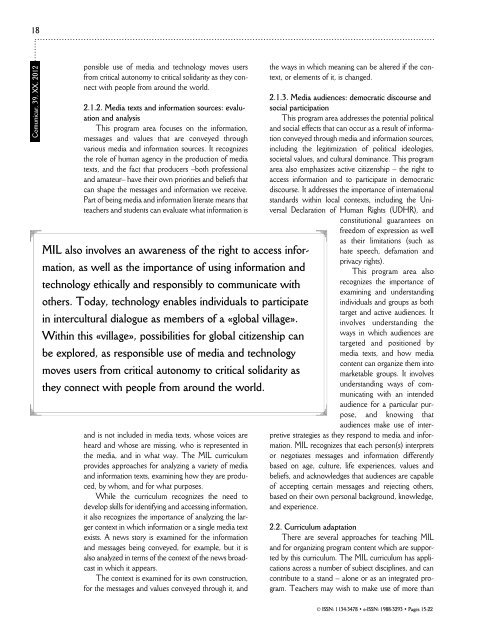Comunicar 39-ingles - Revista Comunicar
Comunicar 39-ingles - Revista Comunicar
Comunicar 39-ingles - Revista Comunicar
You also want an ePaper? Increase the reach of your titles
YUMPU automatically turns print PDFs into web optimized ePapers that Google loves.
18<strong>Comunicar</strong>, <strong>39</strong>, XX, 2012ponsible use of media and technology moves usersfrom critical autonomy to critical solidarity as they connectwith people from around the world.2.1.2. Media texts and information sources: evaluationand analysisThis program area focuses on the information,messages and values that are conveyed throughvarious media and information sources. It recognizesthe role of human agency in the production of mediatexts, and the fact that producers –both professionaland amateur– have their own priorities and beliefs thatcan shape the messages and information we receive.Part of being media and information literate means thatteachers and students can evaluate what information isMIL also involves an awareness of the right to access information,as well as the importance of using information andtechnology ethically and responsibly to communicate withothers. Today, technology enables individuals to participatein intercultural dialogue as members of a «global village».Within this «village», possibilities for global citizenship canbe explored, as responsible use of media and technologymoves users from critical autonomy to critical solidarity asthey connect with people from around the world.and is not included in media texts, whose voices areheard and whose are missing, who is represented inthe media, and in what way. The MIL curriculumprovides approaches for analyzing a variety of mediaand information texts, examining how they are produced,by whom, and for what purposes.While the curriculum recognizes the need todevelop skills for identifying and accessing information,it also recognizes the importance of analyzing the largercontext in which information or a single media textexists. A news story is examined for the informationand messages being conveyed, for example, but it isalso analyzed in terms of the context of the news broad -cast in which it appears.The context is examined for its own construction,for the messages and values conveyed through it, andthe ways in which meaning can be altered if the context,or elements of it, is changed.2.1.3. Media audiences: democratic discourse andsocial participationThis program area addresses the potential politicaland social effects that can occur as a result of informationconveyed through media and information sources,including the legitimization of political ideologies,societal values, and cultural dominance. This programarea also emphasizes active citizenship – the right toaccess information and to participate in democraticdiscourse. It addresses the importance of internationalstandards within local contexts, including the Uni -versal Declaration of Human Rights (UDHR), andconstitutional guarantees onfreedom of expression as wellas their limitations (such ashate speech, defamation andprivacy rights).This program area alsorecognizes the importance ofexamining and understandingindividuals and groups as bothtarget and active audiences. Itinvolves understanding theways in which audiences aretargeted and positioned bymedia texts, and how mediacontent can organize them intomarketable groups. It involvesunderstanding ways of communicatingwith an intendedaudience for a particular purpose,and knowing thataudiences make use of interpretivestrategies as they respond to media and information.MIL recognizes that each person(s) interpretsor negotiates messages and information differentlybased on age, culture, life experiences, values andbeliefs, and acknowledges that audiences are capableof accepting certain messages and rejecting others,based on their own personal background, knowledge,and experience.2.2. Curriculum adaptationThere are several approaches for teaching MILand for organizing program content which are supportedby this curriculum. The MIL curriculum has applicationsacross a number of subject disciplines, and cancontribute to a stand – alone or as an integrated program.Teachers may wish to make use of more than© ISSN: 1134-3478 • e-ISSN: 1988-3293 • Pages 15-22
















